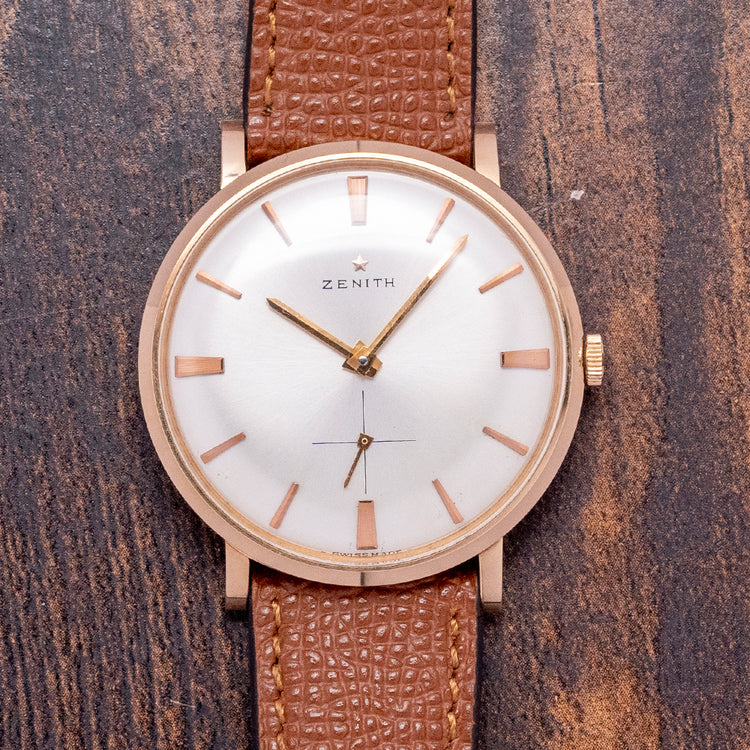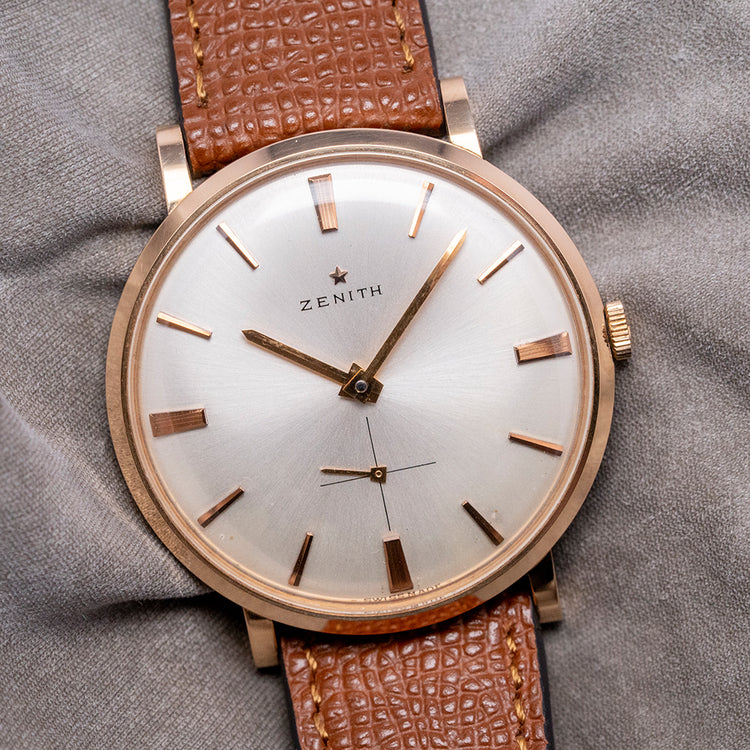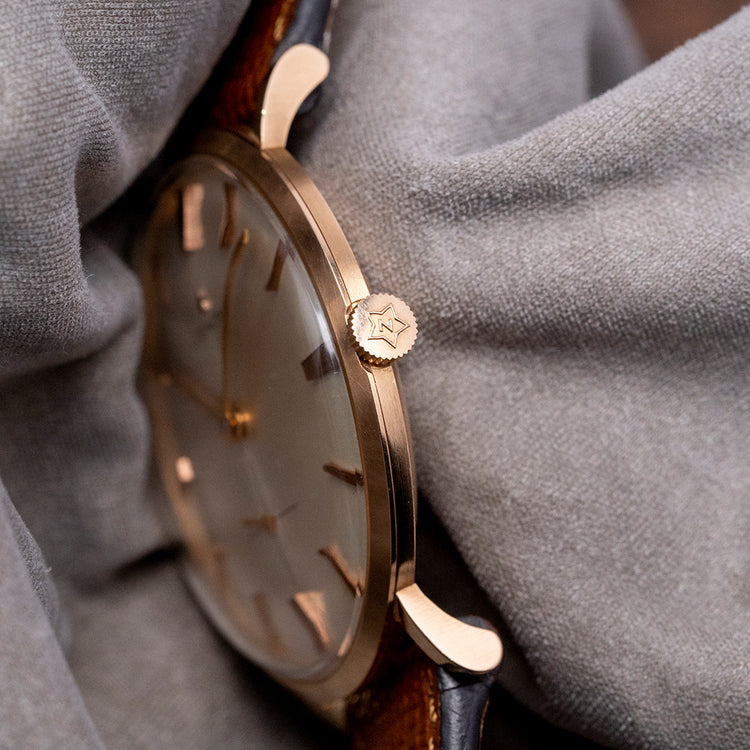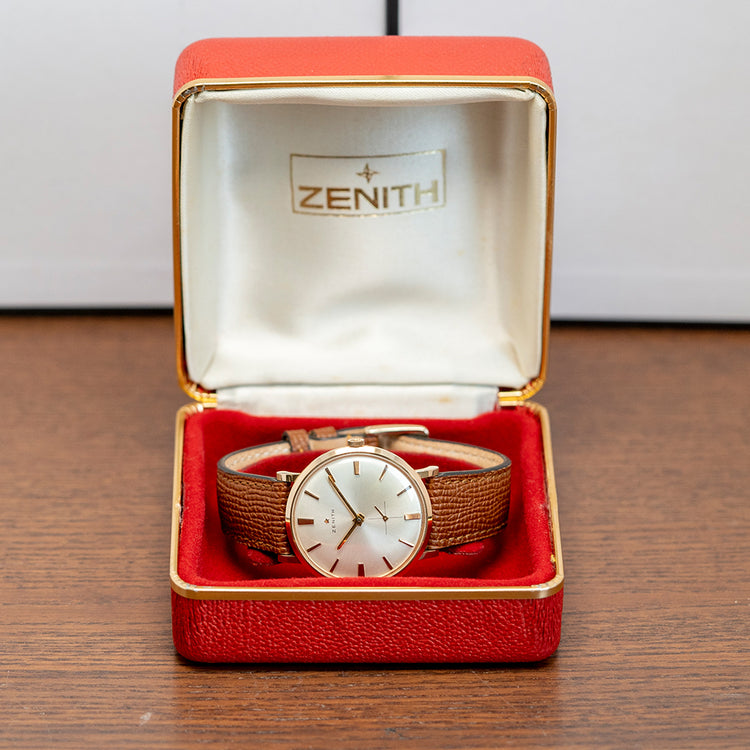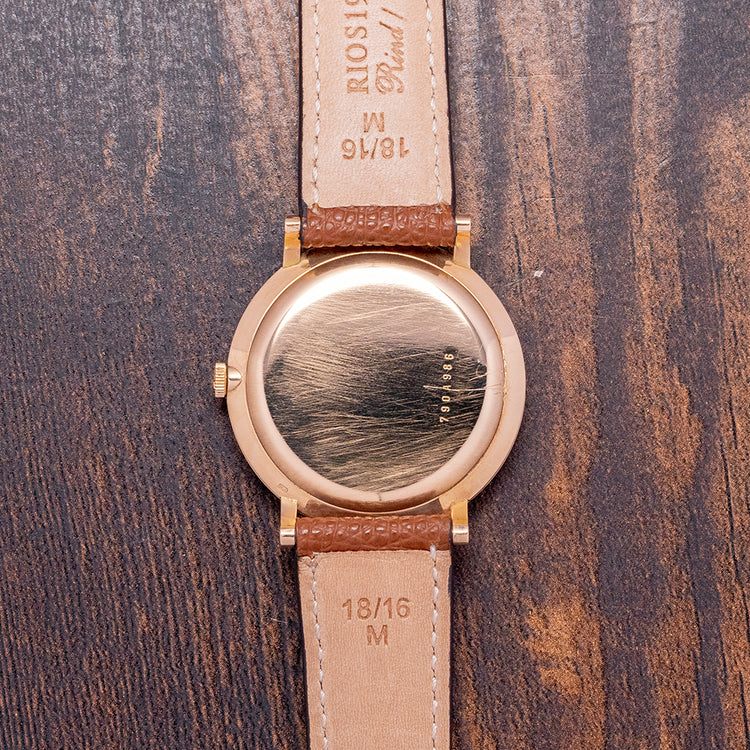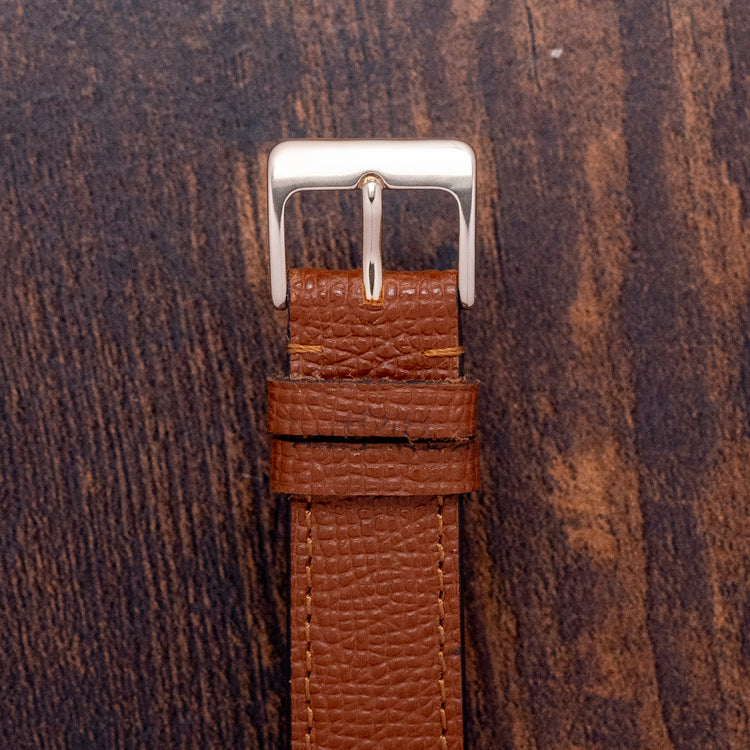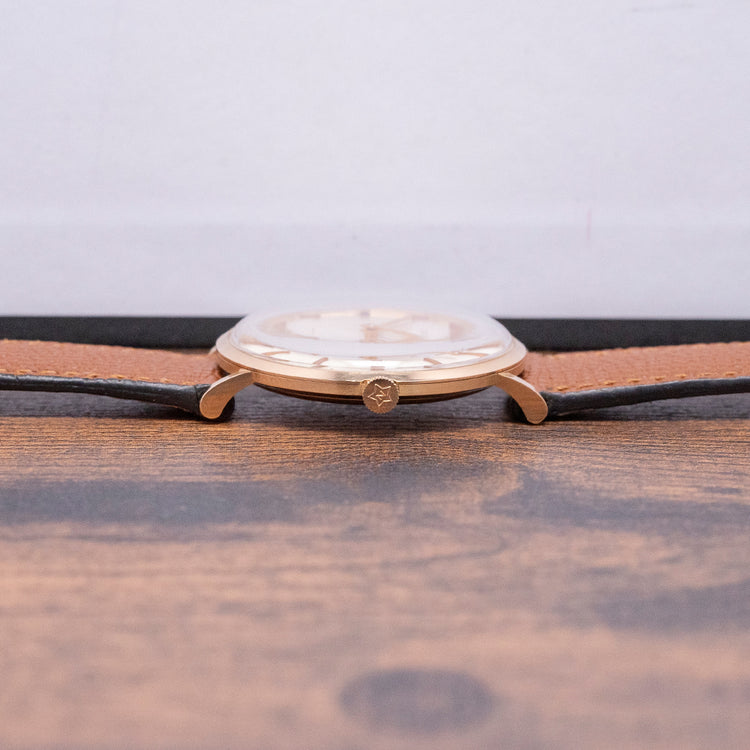More Information
Description
More
Less
More
Less
Here we have a rare 1950s Zenith 'Calatrava' Manual Cal. 2531 with an exquisite 35mm 18ct Pink Gold round case that gently curves over your wrist with teardrop lugs. A lug-to-lug length of 38.5mm and a case thickness of just 7mm ensure a comfortable fit. A signed coin-edged 18ct Pink Gold crown is on the right side. The smooth bezel holds a domed crystal above a striking sunburst silver “Calatrava” dial. Applied facet-edged pink gold indexes catch the light perfectly as you rotate your wrist. Elegant pink gold hands are complemented by a crosshair running seconds at 6 o’clock, and at noon, we have the applied Zenith star motif completing this stunning, beautifully balanced vintage dress watch. On the reverse, a hallmarked snap-off solid case back engraved with its reference number, inside a manually wound Zenith Cal. 2531, 19 jewels, beating at 21,600 beats per hour. It is paired with a well-suited 18mm brown leather strap. This watch is sold with its lovely Zenith presentation box.
Points of Mention
More
Less
More
Less
This watch is sold with its lovely Zenith box. It is paired with a well-suited 18mm brown leather strap. The watch is from Circa. 1950s and is sold in worn vintage condition, but overall, very fair condition for its age, as you can see. The watch comes with our 12-Months Non-Waterproof Warranty.
Personal Note
More
Less
More
Less
Some watches shock me at how incredible they are and how, relatively, they can be such bargains in the vintage watch world. This beautiful Zenith 'Calatrava' in 18ct pink gold is exactly one of those watches, coming in at 35mm with a lovely case, if this said 'Patek' or 'Vacheron' on the dial, it would be an eye-watering amount more. Powered by the manually wound Zenith Calibre 2531, this 1950s beauty packs way above its price tag and deserves serious attention from anyone considering adding a vintage gold watch to their collection. Snap this up today before you miss out!
Specification
More
Less
More
Less
Reference : 790A986
Movement : Manually Wound Zenith Cal. 2531
Age : Circa. 1950s
Year : Circa. 1950s
Case Size : 35mm
Case Thickness : 7mm
Lug to Lug : 38.5mm
Lugs : 18mm
Condition : Pre-Owned
Box and Papers : Box
Case Material : 18ct Pink/Rose Gold
Warranty : 12 Months NON-Waterproof Warranty
The wrist model's wrist size is 7inch
Movement : Manually Wound Zenith Cal. 2531
Age : Circa. 1950s
Year : Circa. 1950s
Case Size : 35mm
Case Thickness : 7mm
Lug to Lug : 38.5mm
Lugs : 18mm
Condition : Pre-Owned
Box and Papers : Box
Case Material : 18ct Pink/Rose Gold
Warranty : 12 Months NON-Waterproof Warranty
The wrist model's wrist size is 7inch
About Zenith
More
Less
More
Less
Zenith was established in 1865 by the ambitious 22-year-old watchmaking prodigy Georges Favre-Jacot. The company established its manufacturing base in Le Locle, a picturesque town in the Swiss Jura Mountains known for its rich horological heritage. The brand gained international recognition in 1909 when the pioneering French aviator Louis Blériot wore a Zenith watch during his historic flight across the English Channel, marking a significant milestone in aviation history. Zenith's watches have adorned the wrists of remarkable adventurers, including the legendary Norwegian explorer Roald Amundsen. He made history by being the first person to reach both the South Pole in 1911 and the North Pole in 1926. As the company approached its centennial celebration in 1965, Zenith’s designers sought to confront the most challenging technological hurdle facing the watch industry: the creation of a self-winding mechanical chronograph movement. Their efforts culminated in the development of the legendary El Primero movement, which was released in 1969. The El Primero, known for its high-frequency escapement and remarkable accuracy, went into production in 1975 and saw a re-issue in 1986. However, the 1960s were turbulent for Zenith due to ongoing litigation regarding naming rights. To navigate through these challenges, the Zenith watch company merged in 1968 with Movado, another respected Swiss brand. This strategic alliance allowed Zenith to leverage Movado’s extensive distribution networks in the United States and stabilise its presence in the market. In 1971, the Zenith Radio Company, which had previously been in conflict with its Swiss counterpart, opted to buy Zenith Watch Company, effectively uniting two entities under the same brand during a challenging period known as the Quartz Crisis. In 1975, Zenith's leadership made the drastic decision to transition entirely to quartz watch production, marking a significant shift in their manufacturing philosophy. This included the controversial decision to destroy all mechanical watch components and blueprints, including those related to the historical El Primero movement. However, thanks to the courageous actions of Charles Vermot, a senior engineer in Zenith’s movement-making department, the company's rich mechanical heritage was saved. Together with a small group of loyal colleagues, Vermot secretly hid the El Primero blueprints and parts in a concealed attic at the factory, preserving them for potential future use amidst the pervasive quartz trend. Vermot’s foresight bore fruit in the 1980s as the market shifted back toward mechanical watches. Prominent brands like Ebel and Rolex reintroduced mechanical chronograph styles, paving the way for Zenith’s revival. The carefully safeguarded El Primero re-emerged as the driving force behind Rolex's hugely successful Daytona series. In 1978, Zenith was acquired from Zenith Radio Company, which is now part of LG Electronics, by Dixi, a company specialising in machine tools based in Le Locle. This transition marked a new chapter for Zenith, which began reintroducing its El Primero-equipped chronograph watches to meet the rising demand for high-end mechanical timepieces. In 1999, Zenith became part of the prestigious LVMH (Moët Hennessy Louis Vuitton) group, aligning itself with other luxury brands such as TAG Heuer and Hublot. Even today, Zenith stands out as one of the few Swiss manufacturers that not only produces mechanical watches but also crafts its own movements.
Description
Here we have a rare 1950s Zenith 'Calatrava' Manual Cal. 2531 with an exquisite 35mm 18ct Pink Gold round case that gently curves over your wrist with teardrop lugs. A lug-to-lug length of 38.5mm and a case thickness of just 7mm ensure a comfortable fit. A signed coin-edged 18ct Pink Gold crown is on the right side. The smooth bezel holds a domed crystal above a striking sunburst silver “Calatrava” dial. Applied facet-edged pink gold indexes catch the light perfectly as you rotate your wrist. Elegant pink gold hands are complemented by a crosshair running seconds at 6 o’clock, and at noon, we have the applied Zenith star motif completing this stunning, beautifully balanced vintage dress watch. On the reverse, a hallmarked snap-off solid case back engraved with its reference number, inside a manually wound Zenith Cal. 2531, 19 jewels, beating at 21,600 beats per hour. It is paired with a well-suited 18mm brown leather strap. This watch is sold with its lovely Zenith presentation box.
Points of Mention
Personal Note
Specification
The Brand
Enquire or Book an Appointment
Would you like to discover further details about this watch, or perhaps arrange an appointment to view and try it on? Complete this form and a member of our team will get back to you shortly.
You May Also Like


























